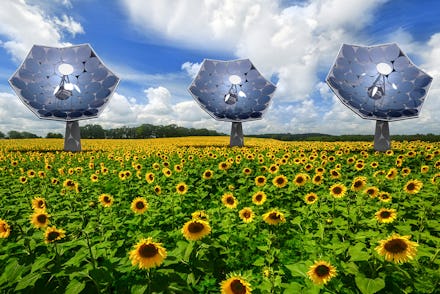'Solar Sunflower': The Future Energy Source That Puts NASA's Solar Panels to Shame

This is the Solar Sunflower, a Swiss-made array that could be the future of solar energy. Looking like a huge, mirrored satellite dish, it combines photovoltaic solar power and concentrated solar thermal power to harness the sun's energy at an efficiency of roughly 80% — a staggering amount.
That efficiency is a whopping 34% more than today's gold standard for solar: the most efficient panels from 2014, cells from Soitec & Fraunhofer Institute used by NASA. They're roughly four times more efficient than any personal solar arrays you'd find powering someone's home.
Another way to put it: The Sunflower, built by Airlight Energy and IBM Research in Zurich, concentrates the sun to "about 5,000 suns," Gianluca Ambrosetti, Airlight's head of research, said to Ars Technica.
The combination of the two technologies, thermal and voltaic, allows the sunflower to go above and beyond what solar panels can do. So, where a typical solar panel might produce 200 watts of electricity, the Sunflower produces 12 kilowatts, or 12,000 watts.
But with great power comes great heat. According to Ars Technica, Airlight's testing involved enough heat to melt a hole in a lump of iron, which has a melting point of 2,800.4 degrees Fahrenheit. Something as small as a misalignment of the panels could lead to the aluminum structural components melting like ice cream on an August afternoon.
So to keep everything cool, Airlight's partner IBM used a hot-water cooling system, which transfers heat from the Solar Flower's computers to the water, then whisks it away to be used as hot water for other applications — like heating university buildings in Zurich.
There are a few problems. On paper, it sounds awesome: big, beautiful sculptures that harness an infinite energy source and could start being constructed all over mountains and farmland. But the Sunflower can produce only enough electricity to power a few homes at a time.
In order to power a city, you'd need hundreds, if not thousands, of Sunflowers, and they won't be nearly as cheap or as scalable as the regular, blue solar panels with which you grew up. The question becomes, "Do I want a cool sculpture, or do I want cheap, renewable energy?"
However, the model is highly promising. If Airlight and its partners can boost efficiency even higher, or build even larger panels for the Flower, it could, hypothetically, get to a point where a single Flower sits on the roof of a building and powers the whole thing, like a big satellite that provides cable TV to an apartment complex. With an efficiency level almost twice that of next-best solar panel, it's a confident step forward on the road to universally used renewable energy — and we could start seeing them pop up by 2016.
h/t Ars Technica